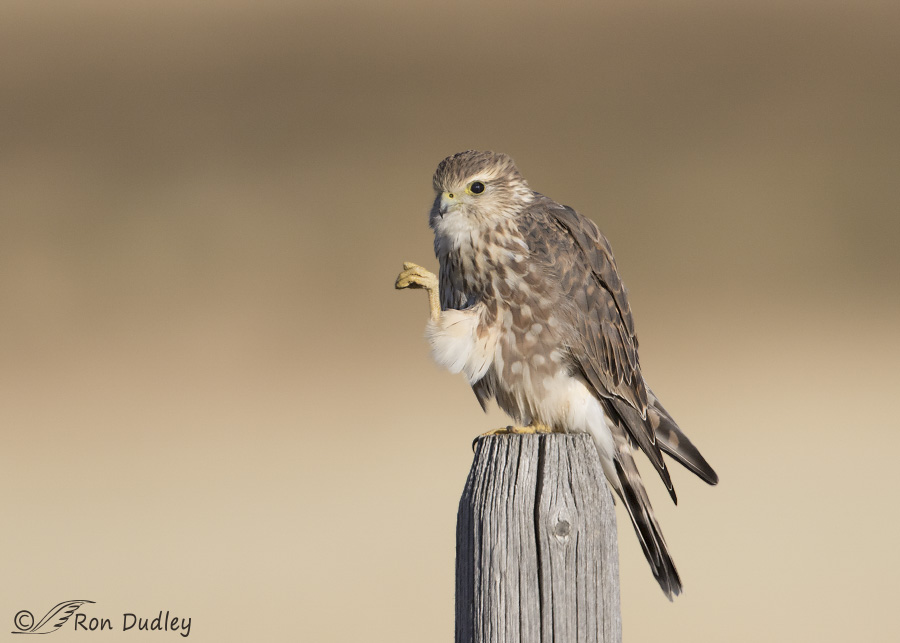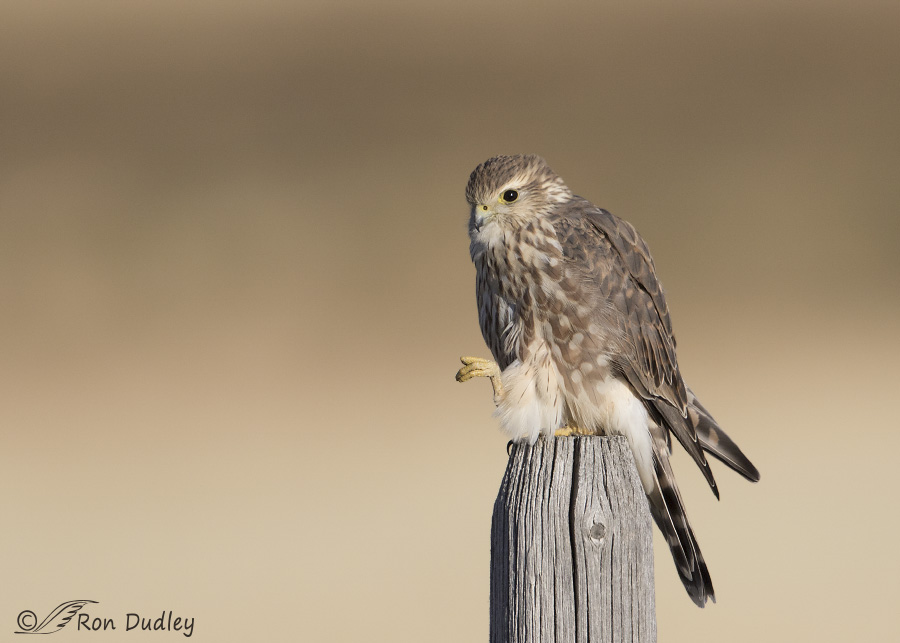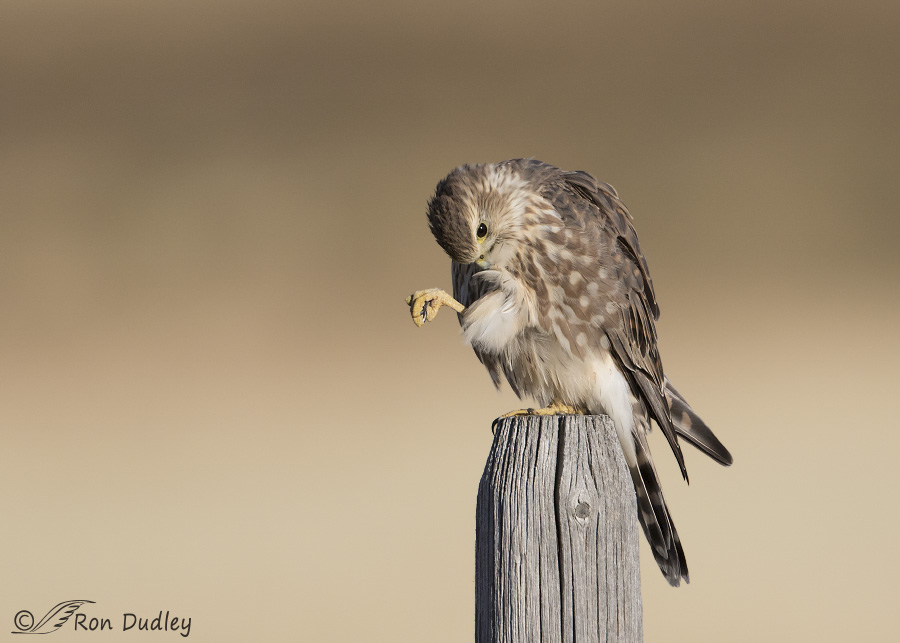I often see this pose from raptors and wonder if it has a “purpose”.

1/3200, f/6.3, ISO 500, Canon 7D Mark II, Canon EF 500mm f/4L IS II USM + 1.4 tc, not baited, set up or called in
I photographed this Merlin just over six months ago in southwest Montana and I believe it to be a female of the prairie subspecies (Falco columbarius richardsonii). Typical of the species she was noticeably more approachable than her slightly smaller cousins the American Kestrels that were common in the area. I was able to photograph her several times during this camping trip but I usually didn’t have a very good light angle on her.
This is a leg pose that I often see from buteos and falcons when they’re perched and relaxed but I’m clueless as to why they do it and most other birds don’t seem to. Occasionally it’s a prelude to grooming but in my experience it usually isn’t. To me it always looks just a little bit silly (but then so do I in some of the contortions I get into when photographing birds…).

1/3200, f/6.3, ISO 500, Canon 7D Mark II, Canon EF 500mm f/4L IS II USM + 1.4 tc, not baited, set up or called in
She held the pose, with minor variations, for quite a while (I took many photos of it) and I really don’t think she had any intention of grooming that foot or leg when she initiated it.

1/3200, f/6.3, ISO 500, Canon 7D Mark II, Canon EF 500mm f/4L IS II USM + 1.4 tc, not baited, set up or called in
But some time later she did begin to groom her upper leg.
Usually when I see this pose from a raptor there is no grooming involved. They just seem to enjoy raising a leg into an awkward-looking position and clenching their “fist”. It’s a behavior I probably see most often in Red-tailed Hawks but then I encounter a lot of red-tails.
As you can see from my camera settings I was prepared for this little falcon to take off but she had other things in mind. Truth be told I often prefer it that way because there’s just something so very special about watching a relaxed raptor up close through my lens. That intimacy with wildness can’t be beat.
Ron


Marvelous shots Ron!
Charlotte
Do I need a manicure? What colour polish?
Nah, I am perfect as I am.
There are an awful lot of commentators and actors arpund these days with English or Aussie accents…seems the latest ” in thing”…do you think that bird might be practising how to hold a proppa cuupa tay???
Aye, mate. By George, that’s it!
Ron. I’m bird sitting a male human imprint first year AMKE. He does this often when comfortable and I’ve not seen it followed by preening. Diana raptor volunteer
That sounds like what I’ve been seeing in some falcons and buteos, Diana.
Hope you’re having fun with that kestrel. I once did the same thing with a male Kestrel named Willie that was a rehab bird that actually lived in the house of my friend. I could never, ever! walk barefoot in the house with Willie around because he would immediately and viciously attack bare toes, anyone’s bare toes. Damn it hurt!
LOL Ron! but when you think about it, toes look like BIG pinkie mice/rats! There’s another body part male falconers need to beware of that looks kinda like a chicken neck. I know, TMI! When I volunteered with On The Wing Again, you learned quickly NOT to wear sandals, especially around the human imprint black vulture! He’d been fed a lot of hot dogs before he was confiscated, and the only near-real food they could get him to eat was chicken necks.
Diana, hope you’re enjoying the Kestrel as well. They’re TERRIFIC birds, but when they get ornery…well, you know that by now! LOL
Interesting, Laura. I thought that might just be an individual quirk of Willie’s.
I enjoyed your “TMI”.
I see it as that old 60’s “right on” motion. 😀
C’mon, Arwen, you haven’t been around that long! 🙂
Grin, just hit the double nickel this year, Professor. 😀
I really enjoy all of your photos, but especially the ones like this. It makes me think about the bird and his habits. Interesting to think that they enjoy standing on one leg, but why not!!
Thanks, Carol. Agreed, if it works, why not do it? Makes for some interesting poses for photographers too.
I’ve found this pose interesting over the years, too. They do it regularly, and while it might be a prelude to preening, they’re also stretching the foot/leg involved in a flexing kind of way.
What’s of particular interest to me is that I cannot find a descriptive word for it in an arcane ancient falconry language context. There’s a word the warble stretch (both wings over the back/head) and the mantle (the one-wing, one-leg stretch with a second meaning of the pose where they’re protecting a kill from view with both wings spread and hunkered down). I’m SURE there had to have been one back there somewhere, but you’d think with the frequency with which they strike this pose, there would be an oft-used word for it.
I’ll ask my vet/falconer friends if they’ve got any more information that would make all of us a little smarter. LOL!
Sorry to be late to this discussion, but I had a hawk-till-you-drop hunting day yesterday to celebrate my entry into Official Geezerhood! 😀 Today is the resulting payback day. We had BIG fun–Jack just loves windy days! He caught two voles, but we really had to work for them. Oh I love that boy, and his little Kestrel sister, too, but she was kind of a snot (as usual). That said, she was a smaller snot than usual. LOL!
Happy Birthday, Laura – though it’s a day late.
Thanks for the info too. If it’s a stretch they can certainly stretch longer than I can/do. Another thing I wonder about is why I almost never see other birds do it but it’s so common with raptors. So many mysteries…
“So many mysteries.”
Yes, indeed. I’m learning new things almost every day with these birds, but I’ve only been at it for 25 years…so much more to discover. And what a joy it is!
Anyway, it’s mostly like a stretch. They can also hold the foot there for some time, so there are other things going on there as well.
As usual, Ron, excellent images and blog. I really like your insight into the birds you capture.
Looks to me with this Merlin, it’s like a person putting one foot on a chair or the next step up to relax. Nick is probably right though.
“it’s like a person putting one foot on a chair or the next step up to relax”
An interesting possibility, Judy.
Wow, Ron – you have definitely got a terrific behavioral series here. It will be interesting to hear what Laura and some of the rehabbers have to say about this behavior. I have becomes so enamoured (sp?) of raptors and your photos are such intimate captures, I look forward every day to what I will see and learn from you and the experienced birders who share their knowledge and experiences. As for this behavior, I couldn’t stand on one leg for 5 seconds so I really admire this birds ability to “strike a pose” for such lengths of time!!!
“I couldn’t stand on one leg for 5 seconds so I really admire this birds ability to “strike a pose” for such lengths of time”
I’ve had similar thoughts, Jo Ann. And they often do it while moving their body around a bit (preening for example) which is even more impressive.
Probably pausing and saying “and what do you want?” or “put ’em up” 🙂 With the foot clenched it doesn’t look comfortable, but then I don’t know how their muscles/tendons work! Nice shots, Ron.
Judy, a FB friend just called this clenched foot pose a “fist bump”. I kinda like that descriptive phrase.
Interesting read, pose and speculation.
Not seen this interaction before, initially was amused by it.
Enjoyed Nicks comment. The first two shots looks to me like she is focused on you, caught with her leg up about to preen. The third shot she decided you were not something to be concerned with and thus can go back to preening. Just my take on it
Dick, there’s no question that she occasionally looked at me and my pickup but the trend of photos like these can be misleading because I keep and post images that have good eye contact and usually delete those that don’t.
But “your take on it” could be spot on – who knows?
Hi Ron,
I thoroughly enjoy reading your blog and viewing your excellent photographs, especially when these relate to birds of prey
I’ve been studying Merlins (and other raptors) for too many decades to count so I too have witnessed this pose many times. I believe it is directly related to preening, exactly as shown in your third image here.
As you suggest, the Merlin in your photograph is obviously relatively relaxed. However, in the two earlier photos she appears to be distracted from preening, perhaps by you?
Preening appears to me to be a relatively pleasant activity for raptors (and probably all other birds) but they can easily become distracted (including presumably for reasons of survival).
My observations suggest that the pose you’ve captured is rather a comfortable position for a falcon and that they can often hesitate in this pose … to scan around for potential threats, to focus in on something happening nearby (e.g. clicks from a camera), or simply to contemplate the world (if birds can do that).
Pure speculation of course but my key take-away from this series of photographs is that the Merlin was fully aware of your presence and actively interested in what you were up to. But that it didn’t feel threatened and was comfortable enough to carry on preening after you’d been given a careful and thoughtful assessment.
Great photos – please keep shooting and sharing.
NPW
Great comment and observations, Nick. You obviously know more about the subject than I do.
But I must say that it didn’t seem to me that she was “distracted from preening” in the first two photos. She made no apparent attempt to preen as she held that pose for a long time before she actually reached for that upper leg.
That said, I’m no Merlin mind reader so you may very well be right. Thanks for your input!
Thanks Ron,
Please take a look at this super videoclip, including delightful commentary, of a Merlin preening in Kent, Washington.
https://www.youtube.com/watch?v=TIBdDN59aYE
If you don’t have much time, simply skip to the 25 second clip between 2:30 – 2:55 and the 20 second clip from 4:00 – 4:20.
Look carefully and you can see this individual holds one leg up for several seconds, but most of the time its hidden by body feathers.
Laura is correct concerning the importance of stretching – I was lumping this behaviour within the term ‘preening’ because Merlins, in particular, commonly integrate and alternate between these two activities.
Falcons frequently roost on one leg for very long periods of time – certainly longer than you and I could achieve, and far more elegantly too no doubt! 🙂
Thanks again and best regards from UAE.
NPW
Thanks very much for the link, Nick – very interesting and I enjoyed the obvious affection the narrator had for the Merlin.
But I didn’t see what I’ve observed with a significant number of raptors – where it holds its closed fist up and out in front of its belly for a good long time without preening. I once watched a Red-tailed Hawk on a fence post in Glacier County, Montana hold that position for an amazing length of time – to the point that I wondered if there was something wrong with its foot. There apparently wasn’t because it eventually stood naturally on both feet before it took off and used them both to push off from the perch.
Wow, UAE. Bet there’s quite the falconry tradition there…
Yes, there’s also the one-leg thing when they bring one leg/foot up into their feathers. You’ll see that often when they roost for the night or when it’s cold and there’s a lull in their hunting. I love seeing them control just those belly feathers, opening them until their foot/leg is placed, then closing them back down.
And like you, I couldn’t hold it for five seconds. They hold it for hours. I have a link about that, too.
Red-tails, like most other birds, have an interesting and useful foot locking mechanism used when sleeping. As the bird begins to nod off, there is a ratchet-like band of tissue that can be tightened around the inside of the leg. Once tightened, it sticks together somewhat like velcro, locking the bird’s grip on the branch.
The hawk doesn’t have to pay any attention to holding on during the night. The bird’s toes are physically locked around the branch, and normal winds cause no problems.”
Here is an article on locking tendon: http://link.springer.com/article/10.1007%2FBF00312195
I used to teach my zoology students about that tendon and the way it works. Also the supracoracoideus muscle which I think is even more fascinating. I even did a blog on it:
https://www.featheredphotography.com/blog/2013/11/14/the-supracoracoideus-an-ingenious-adaptation-for-flight/
Cool Ron! Thanks for sharing! It’s always good to have an arsenal of information during chat times, especially right now in what I like to call The Zen of Incubation! But there’s always the post prandial stupors (nap attacks) of the kiddos for the first three-ish weeks. 🙂